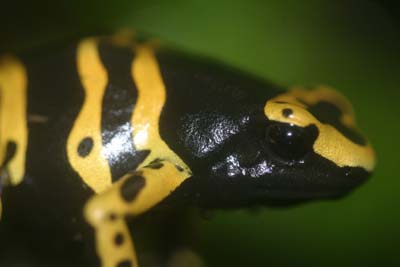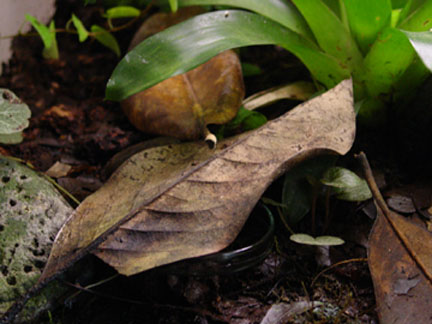Dendrobates leucomelas is a great frog. In the wild leucs inhabit areas of Venezuela, northern Brazil, Guyana and Colombia. They are very common in the pet trade and for many people this is their first Poison Dart Frogs. In our experience these frogs climb a lot and will take advantage of vertical space. They also are a lot more shy than many of the beginner frogs like D. auratus or D . tinctorius, so a heavily planted enclosure makes them feel more secure. They are a large dart frog and come in some different morphs. They spent a lot of time in the higher sections of the enclosure and bromeliads. These frogs will use most of the space in the enclosure. They are not as aggressive feeders as some other PDF's. While we do not mix species in our enclosures, keep this in mind if you are housing them with other species. There is little sexual dimorphism in D. leucomelas. The males can start calling at as young as 5 months and by the time that they are mature should call on a regular basis. The call is very pleasant and quite loud. Calling is the surest way to know that you have a male, but do not assume that non-calling frogs are always female. Although D. leucomelas may be kept communally, often only the dominant male in the enclosure will call, especially if it is a small sparsely planted enclosure. If you separate the adult frogs and mist them heavily this will usually trigger calling in males. You can then take notes on the pattern of all your animals to keep a record of the sex of the individuals. In heavily planted vivaria, the male will call for the female to come to him and continue to call her into the bower. This is where mating takes place. |
D. leucomelas lay clutches of 4 to 8 eggs but a healthy pair can lay eggs every one or two weeks. The eggs are usually laid in a coco hut or similar bower. We leave the eggs in the enclosure for at least 24 hours after finding them to make sure that they are fertilized. The hatch rate for D. leucomelas eggs is usually high. We raise our tadpoles individually in glass mason jars or in nested rubbermaid containers that have dividers and a screen bottom on the inside container. This setup is filtered with a small sponge type air filter. Filtration reduces the number of water changes needed. In this type of setup we keep pathos and aquatic plants in the rearing enclosure. Tads are fed a mixture of spirulina, chlorella, stinging nettle and bee pollen (2:2:1:1), we also feed "Aquarian" fish food about once a week. After the rear legs develop we expose the tads to UVB lighting daily. The tads morph out fairly large and are fed Drosophila melanogaster that are dusted daily with Repcal. We also dust weekly with Herptivite. We follow this dusting regime with our adult frogs too. The frogs reach maturity in 12-15 months.
|
 |
 |
In our experience we have noted that D. leucomelas like a well planted vivarium and prefer to lay eggs under a magnolia leaf instead of the normal coco hut, although as you can see by the picture at the top they still use the coco hut from time to time. At the left is a picture of this set up with a petri dish under the leaf. They also seem to prefer a wetter enclosure than some of our other darts and make an excellent candidate for a vivarium that contains a water feature. We keep the humidity high and do not let the temperature rise above 83°.
Summation:
Size- 35 - 40 mm, visual differences between sexes are not apparent, females may be slightly larger and rounder, males have a loud, pleasant call
Care- Leucs are easy to care for and a good beginner species, although individuals may be shy
Food- all types of fruit flies, small crickets, waxworms, confused flowerbeetle larvae, termites, field sweeping,
Eggs and Tads- clutches of 4 to 8 eggs, tads are omnivorous and should be raised singly
Temperature- 70°-80°
Locality - Venezuela, northern Brazil, Guyana and Colombia
|

